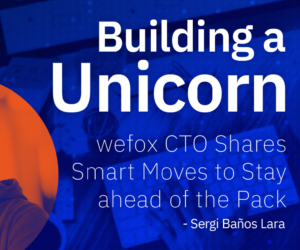The OLX group is a striking example of the recent Classified Ads industry trend of verticalization: the international giant has grown from its beginnings as a purely horizontal concern into a thriving house of verticals, home to over twenty specialist marketplaces. Their engineering director Aniela Crisan has a suitably multidimensional role, leading OLX’s Motor Customers Unit while simultaneously directing the tech stack and engineering teams for the whole group. She recently met with Pentalog Chief Platform Officer Cornel Fatulescu to share her views on a range of issues like the smart use of metrics, inclusive hiring practices and avoiding burnout. She also provided plenty of pointers on how to become an effective tech leader, and you can check out just a few of them below.

Evolve from outputs to outcomes
Crisan’s Motor Customers Unit belongs to a section of the Classifieds industry with high stakes for the customer: a car is a hefty investment for most people, and finding the right parts to keep your vehicle on the road is no laughing matter either. So it’s no surprise that Crisan makes sure all her teams have one clear end goal. “The main thing is customers,” she says. “We want to be customer-centric and to build something that they love, and technology is a means to an end.” Crisan encourages her teams to think in terms of outcomes for customers and other stakeholders rather than just product outputs. This attitude shift is “ongoing and requires a lot of education,” but she’s committed to it. Asking why is at least as important as asking how and how much.
Be smart about data
Crisan points out that as companies scale up, there is less room for decisions based on “gut feelings” and an effective system of metrics becomes essential. “Basically, we measure everything,” she says. But in all this mass of data it’s important to remember its limitations. “We are data-driven, we are not data blind,” she continues. “We’re taking data just for us, to help us make decisions. It’s not something we’re taking to punish someone, or [to] use it blindly without any type of context.” Instead Crisan advocates putting all those metrics to smarter, more proactive uses: avoiding bottlenecks, of course, but also onboarding new resources if necessary and heading off future problems.
Communicate without borders
In a way Crisan’s Unit is a company-within-a-company, a complex agile structure of small engineering teams, tribes and subsets with her in the top tech role. But she must also liaise with the OLX C-suite: she reports to the group-level CEO and works closely with the group’s new CTO, holding weekly meetings where the pair discuss “a mix of everything” from strategy to operations. In this kind of structure, communication is key. “We are always talking to each other,” she says. “We’re set up in a cross-functional way [so] we cannot stay inside our bubbles, or we are not going to create things that really matter.”
Move beyond scrum
Crisan is a firm believer in agile, but she doesn’t always do it by the book. In the early days of the Unit, she found that a standard Scrum approach was useful to get all the teams up to the same level, but now she leaves them a lot more flexibility. She reminds us of the “people over process” principle of agile and says that if her team is learning and improving, “We don’t really care about how they organize […] as long as it’s something that works for them.” Neither does the organization have a dedicated Scrum Master. “This is a role that anyone in the team can take, so it’s very flexible,” she explains.
Remember the human side of the “shift left”
With her teams totaling over two thousand product releases in 2021, it’s obvious that Crisan embraces the DevOps continuous delivery approach. But the “shift left” means that teams need to acquire skills from the later stages of the traditional build cycle such as quality and UX, and with agile’s small teams it isn’t possible to address the skills shortage by just adding more and more team members.
To make sure the right skills are present without overcrowding OR overburdening the teams, Crisan takes a custom approach. Each of her teams is given the set of engineers they need to achieve their mission, and the rest of the engineers are shared out as needed, “almost like service providers.” She cites the example of Site Reliability Engineers: “If you’re putting an SRE in a team that is focusing on front-end, maybe he will spend 90% of the time not doing anything. So we need to be very flexible on how we are using all the engineers.”
Don’t try to run on empty
Crisan notes that the past few years have seen massive upheavals in many peoples’ working patterns, leading to new kinds of burnout. But whatever your schedule and work environment, learning how to clock off remains a core skill for leaders. “You really need to trust your team and always be able to delegate topics to them,” she says, stressing the importance of creating a sound second line.
And when you take that well-earned vacation, make it count! “When I go on holiday I disconnect my workplace because I have the same phone. I don’t see any email. I don’t see any slack messages. I don’t see anything.” And she’s even enlisted the help of a canine accountability partner! “I have a pandemic dog,” she jokes. “Like 99% of the population I got a dog during the pandemic, so then it means that at the end of the day, I have to go out and take her for a walk.”
Keep an eye on recruitment bias
For Crisan, fostering employee engagement begins even before the point of hire. As a champion of women in technology, she is no stranger to the topic of bias in the recruitment process, whether it be based on gender, race, nationality or anything else. To minimize bias, Crisan urges managers to monitor their own reactions carefully when interviewing candidates. She shares a useful tip for combating the famous halo/horn effect (where the first impression made by a candidate ends up exerting too much influence on the final hiring decision): “I put a plus or minus if I know the first impression was very good or was very bad, because then I know that maybe the rest of the interview will be influenced by that first opinion,” she confides.
Ana finally: Create your own flavor
Crisan often hears “people saying, ‘No, I cannot be a CTO because I don’t have that type of experience,’ but actually there are so many flavors of CTO that you can be. But first you need to figure out what it is.” This means finding role models such as mentors who can explain the role and help you build up the confidence to play it.
And it’s a two-way process: “In the same way we need to be role models for people that want to grow,” she says. It’s all about “telling our stories, what we are doing, why we are doing that, how we got there.” This will inspire the listener to either follow that model of leadership or reject it in favor of something more their style, finding “the version they’re happier with.” The old Socratic maxim “know thyself” certainly applies to the tech leaders of tomorrow, but they also need to know each other.









